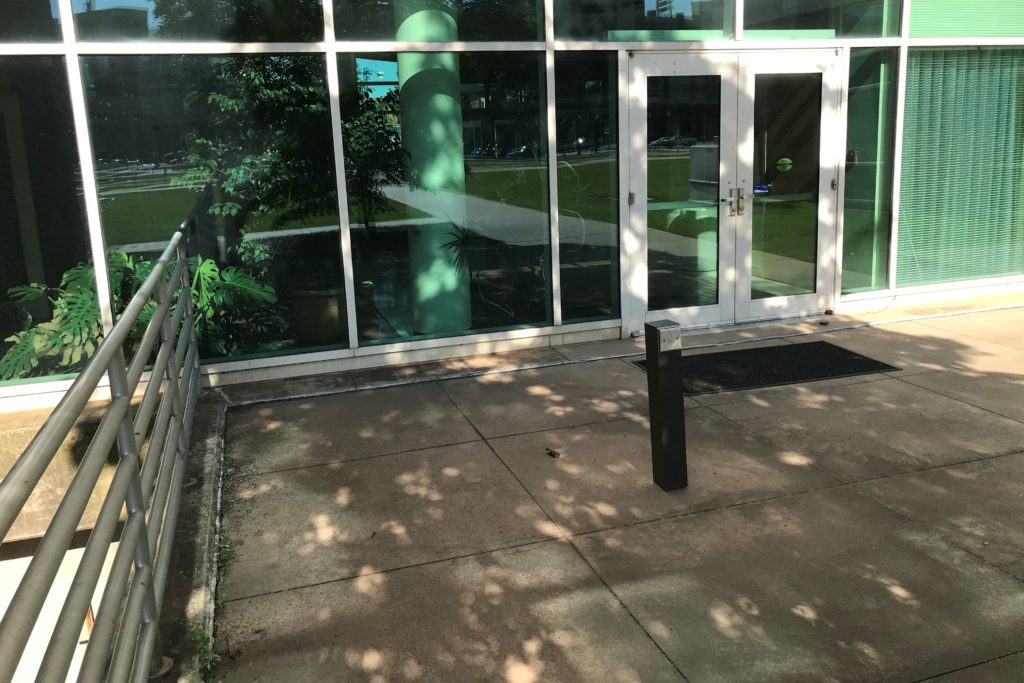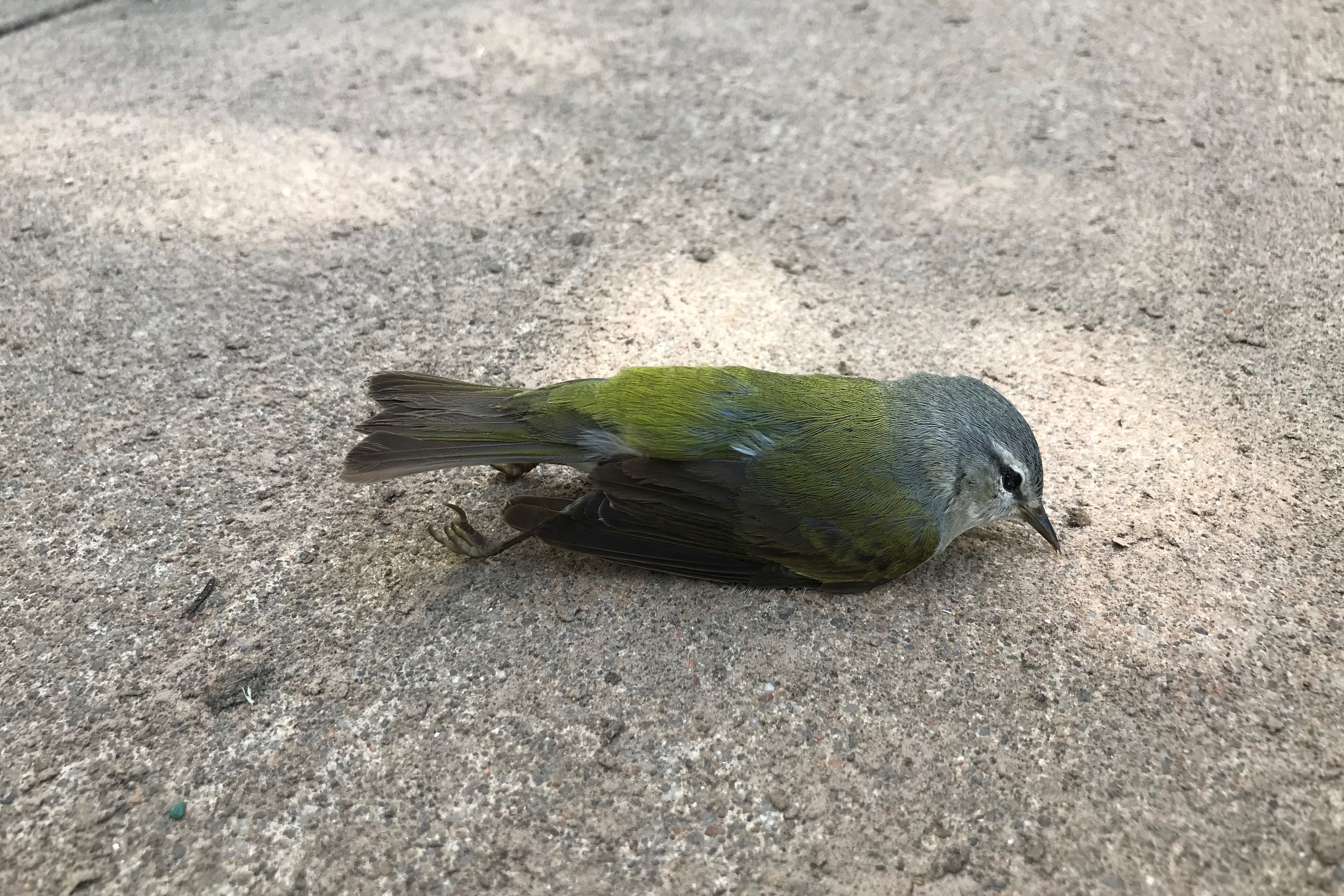By Tim O’Connell
Linked paper: Building façade-level correlates of bird–window collisions in a small urban area by C.S. Riding, T.J. O’Connell, and S.R. Loss, The Condor: Ornithological Applications.
You have probably heard the startling impact of a bird hitting a glass pane, or perhaps you’ve come across a dead bird beneath a window. While the effect on the bird was lethal, you were likely affected by that event too. People don’t want birds to die at their windows, and they are increasingly looking for solutions when they discover collision problems at their homes and businesses.
Birds can be at risk wherever they encounter glass in their environment, but that risk varies from place to place. Identifying what causes some areas to be collision hotspots can inform building retrofitting and design approaches that make windows safer for birds. We know, for example, that coastlines and other features that concentrate migrants can put more birds at risk of colliding during their spring and fall migrations. Tall, glassy buildings ––especially those lit from within at night –– can be particularly dangerous for migrating birds. Smaller buildings and homes outside of major flyways are sites of collisions, too, and features that attract birds, such as vegetation or feeders, also can increase those collisions. Beyond that, we still have much to learn about the fine-scale factors that put birds at risk of collision.
I started keeping track of window-killed birds in 1993. One day I stumbled (almost literally) across five collision victims along one façade of a single building in a corporate office park. All five were Nearctic-Neotropical migrants. This wasn’t a coastal skyscraper or a home with bird-attracting feeders. This was a group of unremarkable, three- to five-story buildings surrounded by manicured lawns and small forest patches. You might know of such a place in your own community. I have been searching such places for window-killed birds ever since.

In my experience, some things about bird–window collisions in such developments are predictable. Collision rates are seasonal; migrants in passage are disproportionately represented compared to residents. Other things are unpredictable. For example, despite the prevailing directions of travel that birds follow in migration, fine-scale movements, local attractants, and specific architectural features of buildings largely determine the location of collision hotspots.
My Oklahoma State University colleagues Corey Riding and Scott Loss and I recently investigated sources of that fine-scale variability at homes and mid-size buildings in our small city (pop. 46,000) of Stillwater, Oklahoma. Corey and his technicians (and sometimes his children) walked mile upon mile to survey about fifteen building perimeters for window-killed birds over two years. Rather than summarize the data by building, Corey analyzed carcass locations to within two meters of where they were found. This allowed us to examine mortality by individual façades –– by season and by year for at least eight of the 63 species we confirmed as collision victims. The variability in risk factors among species provides direction for future research, but there were some generalities in the results. Long, tall façades with a high proportion of glass surface area were the most deadly for the most species. Indentations in a building’s shape, such as façades at the terminus of an alcove, also accounted for a disproportionate number of collisions compared to flat or curved façades.
Ours is the latest of multiple studies to confirm that a high proportion of glass area is a strong predictor of collision hotspots. Reducing the loss of birds to window collisions depends on a societal commitment to reduce the overall surface area and proportion of reflective glass in both newly designed and existing buildings. Our example of methods and analysis to tease out fine-scale influences on bird-window collisions is highly repeatable and can help guide actions to reduce collisions in other communities. Lessons from this research are already informing collision mitigation strategies and future bird-friendly architectural designs on our campus. We welcome the news of any community to make such commitments; there is much work to be done.

It’s weird how alive that Tennessee Warbler looks in the first photo–notwithstanding the awkward posture of the bird, its “bright” eye gives the strong impression to me that it is still alive!
Part of that Bob might be that I’m checking every day (at least in pre-COVID times). I’ve often come upon birds that had collided mere moments before I found them.
I installed Acopian Bird Savers (www.birdsavers.com) and have cut my window kills by 90%, as well as strikes without killing. The method uses parachute cord hanging from top of windows at 4.25 inches apart, based on research. I just got tired of killing wood thrushes and other neotropicals and had to do it regardless of cost. Buy your own cord for the cheapest way to install. They sway in the wind and do not impede window cleaning. Last year I only killed a couple birds, a Common Yellowthroat and a female Purple Finch, previous years over a dozen species and many individuals. But never an American Robin, attesting to it’s cohabitation with man and possible selection for window avoidance. Hello Tim and Bob M., former bird technical committee members in PA.
Hi Bob – great to hear from you! I’m also glad that you’ve had good success with Acopian Bird Savers. They look to be an elegant solution for this pernicious problem.
Thank you for your work, it’s encouraging to read this type of study for one wonders if anyone cares, at times. I personally use translucent decals from https://windowalert.com/ and have seen a drastic reduction of collisions. t’s always nicer to have a clear window but you easily get used to them and don’t really notice them from inside. I have tall windows due to a cathedral ceiling but I always put those decals on in April and remove them in October. A bit of work, indeed but oh, so worth it!
In Canada it is the Law to build certain non reflective glass in all buildings.. It may help for you to make that comparison to others so they can follow suit.